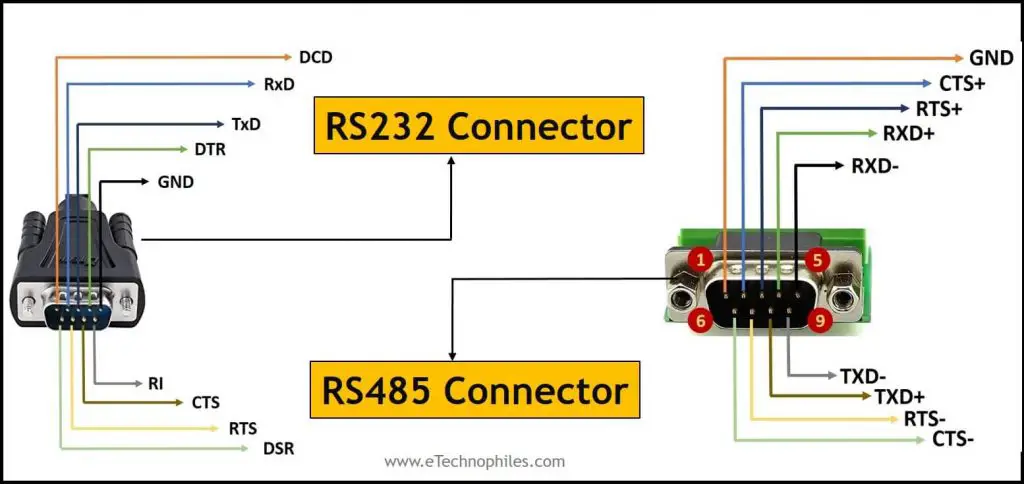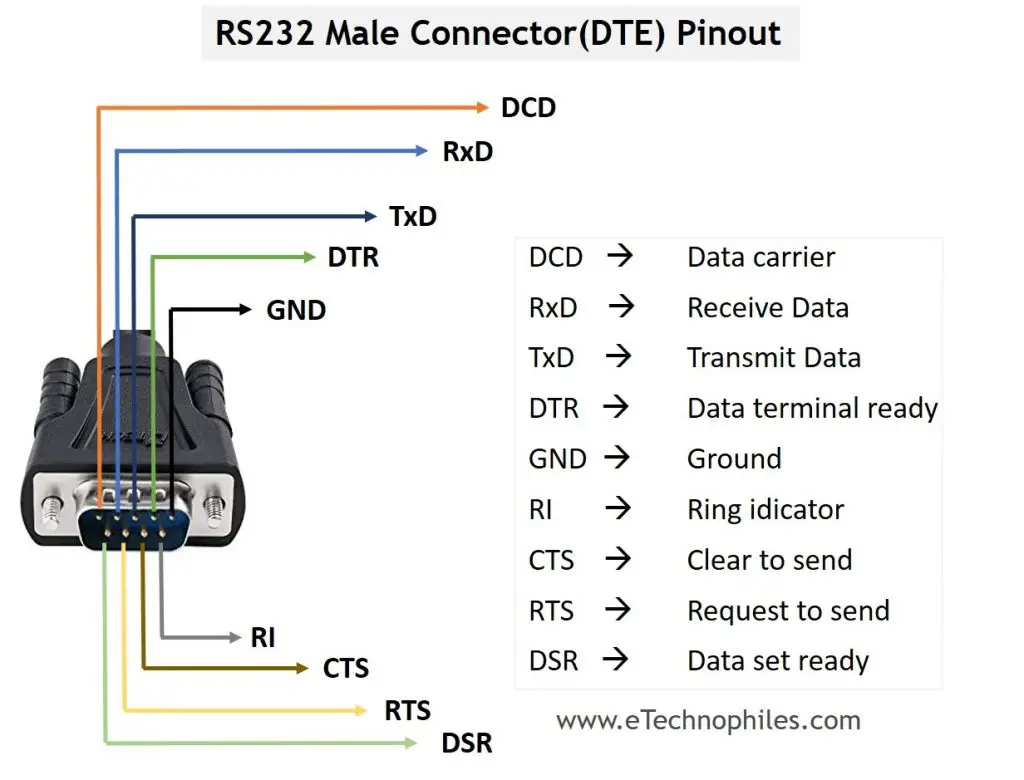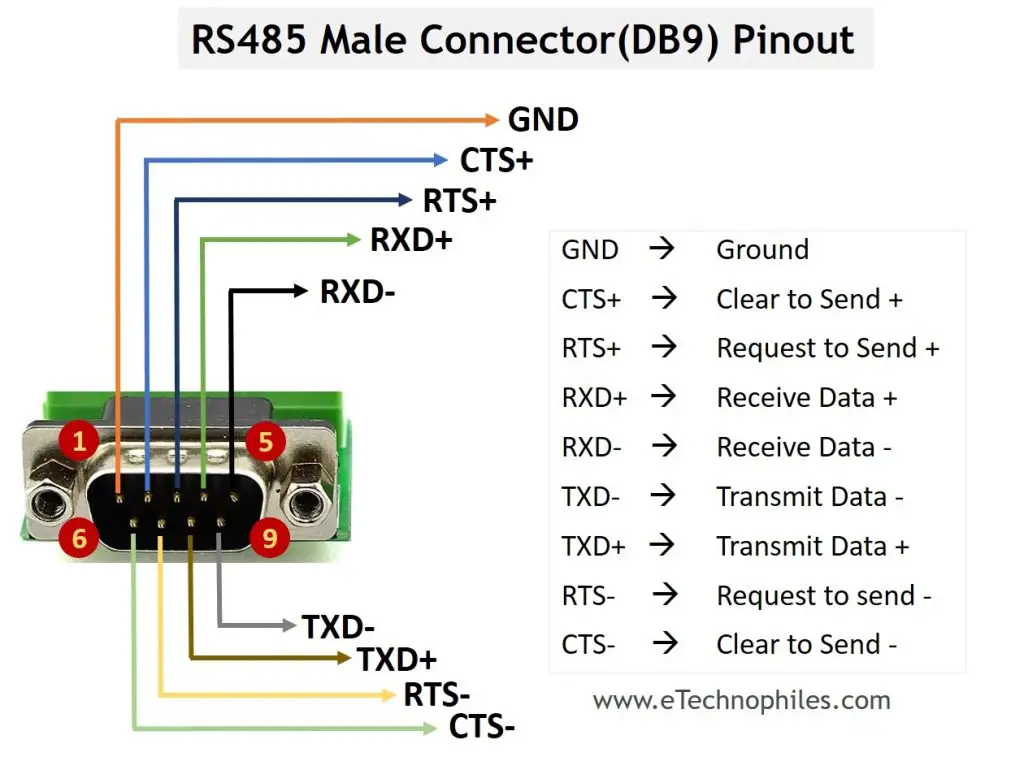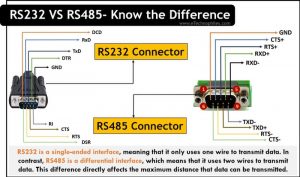Last updated on March 21st, 2024 at 11:48 am
RS232 and RS485 are two popular serial data communication protocols. These were established by the Electronic Industries Association (EIA) and are used for the communication between a system and a peripheral. But they are almost replaced with the USB standard these days.

RS485 is an advanced version of RS232. Hence RS485 was designed to solve or improve several limitations and features of RS232. An advantage of RS485 was that it supports the same DB9 cable and connectors used by RS232. Thus it was not necessary to use different cable and connector models.
RS485 was introduced with several enhanced features compared to RS232. Let us do a comparison for both standards.
RS485 and RS432 differ in the following aspects:
- Line configuration
- Mode of operation
- Mode of connection
- Signaling type
- Wiring/Pinout
- Cable length
- Data rate
The differences between RS232 and RS485 are consolidated in the table below.
| Parameter/Feature | RS232 | RS485 |
|---|---|---|
| Line configuration | Single-ended | Differential |
| Mode of operation | Simplex or full-duplex | Simplex or half-duplex |
| Type of Connection | Point-to-Point | Multi-point |
| No.of Devices Possible to Connect | 1 | 32 |
| Signaling | Unbalanced | Balanced |
| Direction | Bi-directional | Uni-directional |
| Wiring | Straight-through Connections | Cross-over Connections |
| Maximum Cable Length | 50 feet | 4000 feet |
| Maximum Data rate (at max. cable length) | 20 Kbps | 10 Kbps |
| Maximum Data rate possible (very short distance) | 1 Mbps | 10 Mbps |
These differences are explained in detail below.
Line configuration
RS232 uses a single-ended signaling method, which means that there is only one signal line between the transmitter and receiver. RS485 uses a differential signaling method, which means that there are two signal lines between the transmitter and receiver. Differential signaling is less susceptible to noise interference than single-ended signaling.
Mode of operation
RS232 transmits and receives data in both directions whereas, RS485 supports transmission and reception in a single direction at a time.
This makes RS232 a bi-directional interface and RS485 a uni-directional interface.
Mode of connection
RS485 can connect with multiple devices at a time. It can connect and talk with up to 32 devices. These features created numerous applications for RS485.
RS232 supports a point-to-point connection where it can connect with only one device at a time. That is, a system can be connected with only one peripheral at once using RS232.
RS232 VS RS485 pinout and wiring
RS232 protocol uses a 9-pin DB9 connector. The pinout of the male RS232 connectors is shown below.

RS485 uses the same DB9 connector but the connections to the pins are different since it requires positive and negative pins for transmission and reception.

Note: The winding fashion of RS232 is a straight-through connection. But RS484 has cross-over connections in its wiring.
Similar: VGA Pinout, Features, Advantages & Disadvantages
Signaling
RS232 uses unbalanced signaling by which only one pin is used for transmission and reception. Thus RS232 has two data transfer pins.
But RS485 uses a bipolar strategy where a set of positive and negative pins are used to transmit and receive signals. Thus 4 data transfer pins are used by RS485.
Maximum cable length
RS232 is typically used for shorter distances, up to around 50 feet, and does not require special wiring or termination. RS485 can be used for much longer distances, up to 4000 feet, but does require special wiring and termination.
Maximum data rate
RS485 also introduced advancements in the maximum data transmission rate. RS232 can transmit the data at 20 Kbps(max) whereas RS485 was introduced with a tremendous increase in data rate up to 10 Mbps(max).
RS232 VS RS485- conclusion
RS232 is a single-ended interface, meaning that it only uses one wire to transmit data. In contrast, RS485 is a differential interface, which means that it uses two wires to transmit data. This difference is important because it affects the maximum distance that data can be transmitted.
RS232 is limited to a maximum distance of 50 feet, while RS485 can be extended up to 4000 feet. In addition, RS232 uses a single-ended voltage swing, while RS485 uses a differential voltage swing. This means that RS485 can tolerate higher levels of noise and interference. As a result, RS485 is typically used in industrial applications where long distances and high levels of noise are present.
FAQs
Why convert RS232 to RS-485?
RS-485 conversion from RS-232 extends communication distance, improves noise immunity, allows multi-drop configurations, supports higher data rates, and offers cost-effectiveness. This transition is common in industrial settings for longer-distance communication.
What is the use of the RS-485 converter?
RS-485 converters are used in various industrial applications such as factory automation, process control systems, building automation, HVAC (heating, ventilation, and air conditioning) systems, access control systems, and instrumentation.
